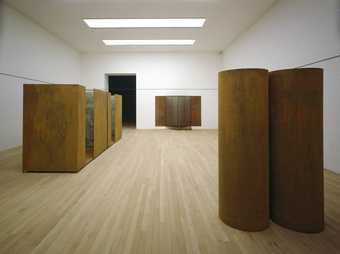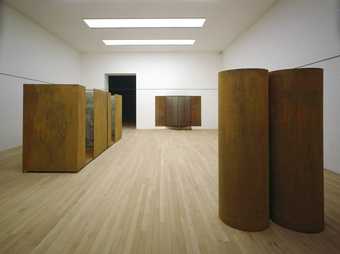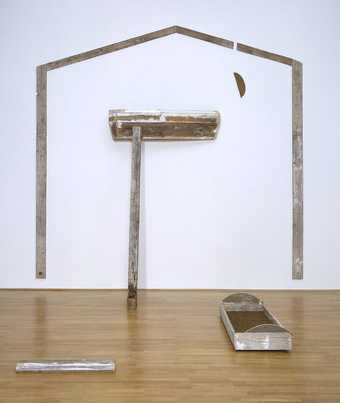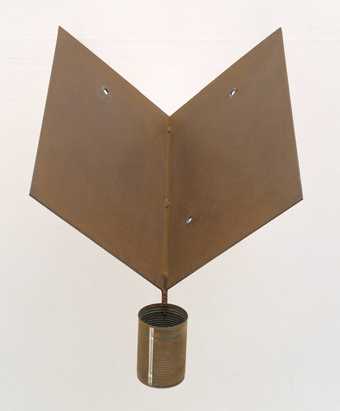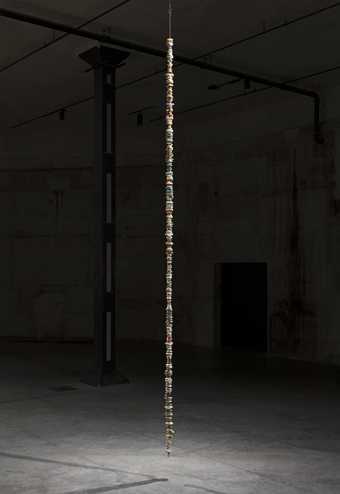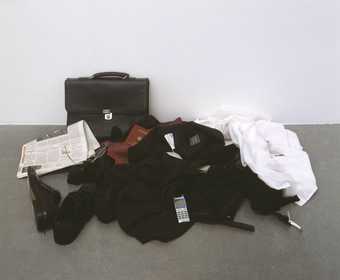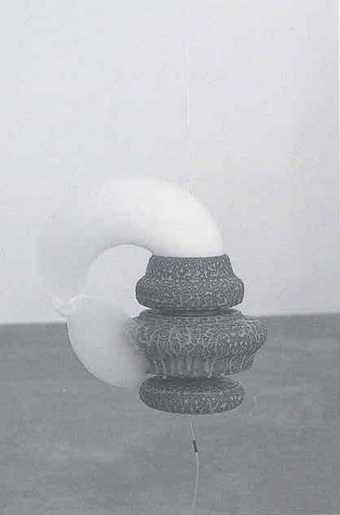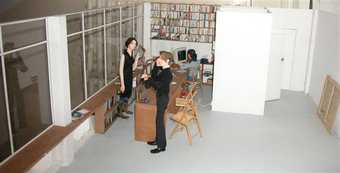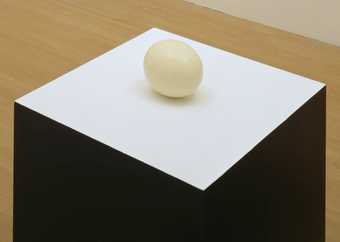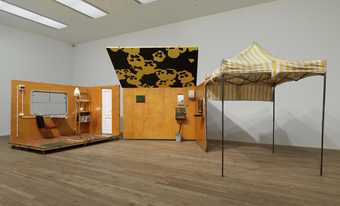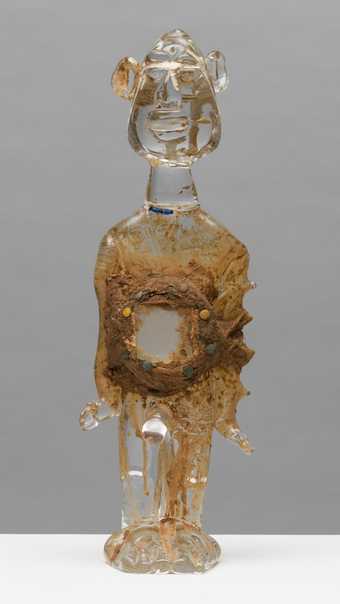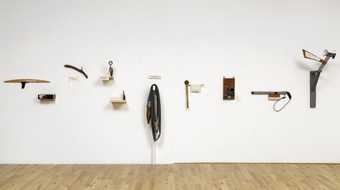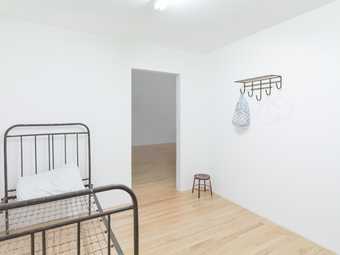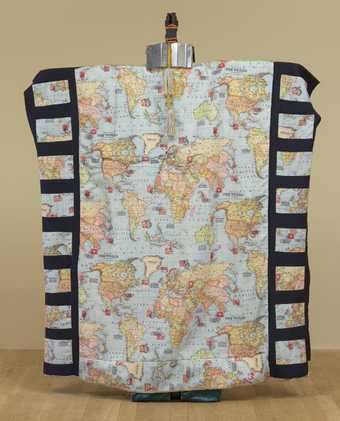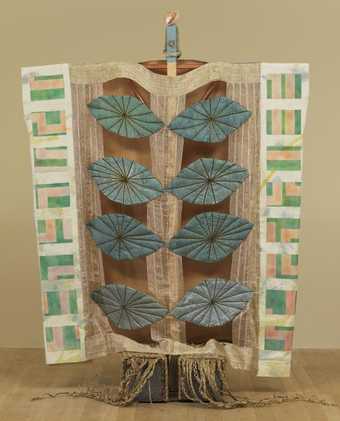Sorry, no image available
Not on display
- Artist
- Pawel Althamer born 1967
- Medium
- Animal intestines, straw and hair over metal, plaster, porcelain, artificial wig, wooden floor, video camera, mobile phone, wrist watch, cotton thread and other materials
- Dimensions
- Object: 1760 × 735 × 1110 mm
- Collection
- Tate
- Acquisition
- Presented by Tate Patrons 2011
- Reference
- T13573
Summary
Monika and Pawel is a free-standing sculpture consisting of a male and female figure standing on a portion of wooden ‘parquet’ flooring. The title of the work identifies the nude figures as the artist and his first wife. The two figures are standing side-by side fully immersed in operating their respective electronic consumer gadgets, in his case a video camera and in hers a mobile telephone. The figures are formed from bunches of straw, shaped according to muscular anatomy, sewn with threads of various colours to a hidden metal armature. Animal intestine covers the straw, representing life-like skin. In places, this is degraded to reveal the straw stuffing underneath. Faces, toes and fingers are made of plaster, toned to skin colour, and the eyes are porcelain. The male’s hair may be real, glued to the head, while the female has a wig made of artificial hair.
When the work was last shown at the New Museum in New York in the exhibition After Nature in 2008, it was discovered on unpacking that it had suffered extensive damage due to moths eating the gut exterior. The damage was such that the stuffing used to model the figures became exposed in a number of areas. On seeing the work in this new state, the artist was happy with its appearance and, after treatment to eliminate the infestation, reconceived the work in its current form.
Althamer’s figurative works have typically been self-portraits or portraits of family members and this work is consistent with this theme. The artist has repeatedly returned to the self-portrait through various modes and in various media as a means to question his own identity and, by extension, that of others. Self-Portrait as a Businessman 2002–4 (Tate T11913) is one such example. For this, Althamer adopted the guise of a businessman before abandoning this role along with the clothing and attributes he had equipped himself with, which then became the sculptural work or residue of the performance. Althamer’s full-figure self-portraits tend to be nude studies without the clothing or costume that might further identify the artist as belonging to a particular class, location or position. In the case of Monika and Pawel, the male and female couple can be seen to evoke the tradition of depicting Adam and Eve who, however, are tempted not by an apple, but by technology.
Althamer first made figurative self-portraits while he was still a student at the Academy of Fine Arts in Warsaw. His first such sculpture, also a figure made from grass and animal gut, was produced when he was given the task of making a classical model by his teachers at the academy. Instead of covering a wire frame with clay in the traditional, time-honoured manner, Althamer used bundles of grass that he had carefully sewn and woven together to create his figure. This method enabled him to reproduce the intricate structure of muscles with great precision. In the catalogue for Althamer’s exhibition at the Kunsthalle in Basel in 1997, curator Andrzej Przywara describes one of Althamer’s figurative works as follows:
The anatomy of the figure was rendered with the utmost precision: different-sized pieces of animal bladders, intestines and hide were stretched over the bundles of grass making up the man’s muscles, left to dry and then sewn together. The result was a complete human being with flesh, skin and bones. Through transparent places and along the seams one can see the figure’s fibrous rotting insides.
(Przywara 1997, unpaginated.)
Like the work Study from Nature described above, Monika and Pawel is insistently visceral, both in terms of its materials and its painstaking verisimilitude. It makes reference to classical sculpture but undercuts the idealism of such work with its abject force.
Further reading
Andrzej Przywara, Pawel Althamer, exhibition catalogue, Kunsthalle Basel 1997, unpaginated.
Pawel Alhamer: The Vincent Award 2004, Ostfildern 2005.
Liliana Basarab, Ziad Antar, Céline Ahond and Pawel Althamer, Espace 315, exhibition catalogue, Centre Georges Pompidou, Paris 2006.
Jessica Morgan
May 2011
Does this text contain inaccurate information or language that you feel we should improve or change? We would like to hear from you.
You might like
-
Miroslaw Balka [diameter]60 x 190, [diameter]60 x 190
1995 -
Miroslaw Balka 250 x 120 x 194, 250 x 120 x 194
1995 -
Miroslaw Balka Oasis (C.D.F.)
1989 -
Miroslaw Balka 50 x 60 x 38
1998 -
Miroslaw Balka 480 x 10 x 10
2000 -
Pawel Althamer Self-Portrait as a Businessman
2002, with additions 2004 -
Roger Hiorns Untitled
2003 -
Pawel Althamer Foksal Gallery Foundation
2004 -
Edward Krasinski Untitled
2001 -
Pawel Althamer, associated with Wilhelm Sasnal, associated with Monika Sosnowska, associated with Jakub Julian Ziolkowski, associated with Artur Zmijewski FGF, Warsaw
2007 -
Pascale Marthine Tayou Poupée Pascale #09
2014 -
Jimmie Durham Untitled
1993–2012 -
Mona Hatoum Interior/Exterior Landscape
2010 -
Tamara Henderson X-RAYED PATH
2016 -
Tamara Henderson The Other Alien
2016

